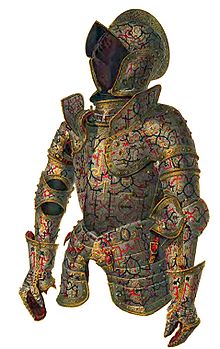- Demi-lancer
-
The "Demi-lancer" or demilancer was a type of heavy cavalryman found in Western Europe in the 16th and early 17th centuries.
Contents
Characteristics
Demi-lancer is a term used in 16th century military parlance, especially in England, to designate cavalrymen mounted on unarmoured horses, armed with the heavy lance of a man-at-arms but wearing three-quarter or half-armour, as opposed to the full plate armour of the knight or gendarme. The breastplate and shoulder defences of the demi-lancer were intended to be at least pistol proof. Often an open faced helmet, such as the burgonet, was worn in place of the fully enclosing close helm. The armour for the leg was replaced by long, cuff-topped, riding boots. In addition to the lance the demi-lancer would be armed with one or two pistols, housed in saddle holsters, and a sword.[1] Demi-lancers were representative of the early modern trend of reducing the coverage of armour while increasing its thickness to provide protection for the vital areas against the fire of gunpowder-based firearms of the time, such as the arquebus and musket. This abbreviated armour was also meant to increase the mobility of the men and horses, as well as reducing the expense inherent in equipping and maintaining them throughout a long campaign.[1] In common with other 16th-century cavalrymen, the demi-lancers were frequently used to strike the enemy's flank and to chase down routing troops.
Recruitment
Demi-lancers were prominent in the English troops who fought in the Dutch War of Independence, and were mobilised as part of the defences of England against the invasion threat posed by the Spanish Armada. In all 2,711 demi-lancers were raised in England in 1588, the Armada year.[2] The English demi-lancers were raised using the "Trained Band" system, and from the feudal levy on nobles and ecclesiastics.[3]
Demise
The demi-lancer was replaced by similarly armoured cavalry whose primary armament was pistols, variously termed pistoleers, cuirassiers or reiters, or cavalry with less armour using longer firearms (doglock carbines) called "harquebusiers." The trend towards the loss of the lance began in Germany in the mid 16th century, France had largely abandoned the lance by 1580, and England by 1600. The use of the heavy lance was found in military treatises up to the mid 17th century but its practical use had died out well before this date. The Battle of Coutras (October 20, 1587), between Henry of Navarre, and the Duc de Joyeuse, during the French Wars of Religion illustrated the demise of the heavy lancer. Navarre's cavalry were 1,300 armoured pistoleers whilst the Royalists under Joyeuse were 2,000 heavy lancers (gendarmes). Within a few minutes of combat the lancers had been routed, many being captured and held for ransom. [4] Only the hussars of Poland retained the heavy lance into the late 17th century. The use of the heavy lance required great skill and constant practice, the use of pistols in battle was far less demanding. This is probably one factor behind the disappearance of the heavy lancer in Western Europe, another being the widespread adoption of the infantry pike.
Notes
References
- Tincey, J. and Turner, G. (2002) Ironsides: English cavalry, 1588-1688, Osprey Publishing ISBN 1-84176-213-X
- Oman, Sir Charles W. C. (reprinted 1998) History of the Art of War in the 16th Century, Greenhill Books. ISBN 0947898697
Categories:- Cavalry
- Military units and formations of the Early Modern era
- 16th and 17th century warrior types
Wikimedia Foundation. 2010.

